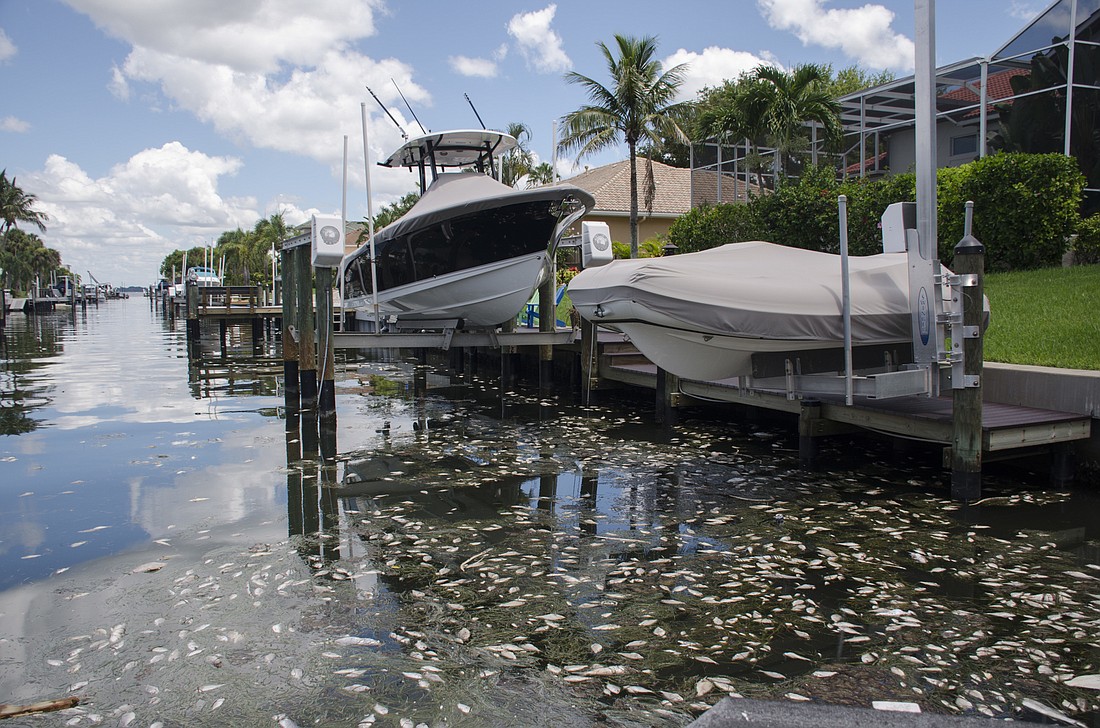- December 12, 2025
-
-
Loading

Loading

Red tide has arrived on Longboat Key, bringing piles of dead marine life and a strong odor to both the gulf and bay sides of the island.
The smell of rotten fish has spread across the island as a bloom of Karenia brevis has been killing sea life across southwest Florida for weeks and slowing moving up the coast. Public Works crews have spent the last few days surveying the island and found “mild to moderate” amounts of dead fish on the island's beaches, said Isaac Brownman, public works director.
The real problem again is in the canals, said Mark Richardson, a public works manager in charge of red tide cleanup. It's the canals that Richardson said town staff have plans to clean first, work that began Tuesday morning.
As of Aug. 3, background to high concentrations of K. brevis were found in 24 samples collected from Sarasota County beaches or offshore, the Florida Fish and Wildlife Conservation Commission website said. The Anna Maria Island police issued a statement on Monday acknowledging the effects of red tide had arrived there too.
Jeff Mayers, general manager of the Resort at Longboat Key Club said his resort has not seen “significant cancellations to date.''
Steve Herich, a fishing guide and coach with Beach Fishing Adventures, said four of his fishing expeditions scheduled between Thursday and Monday were canceled. He said he doesn't remember a time when red tide was like this.
On Tuesday, Aug. 7, though, Herich ventured to the groins near North Shore Road on Longboat and said conditions seemed to be better. In an email, he said he saw a few dead fish, but he didn't experience throat irritation or sneezing. He also saw various species of fish swimming around, including snook and snapper and said the water clarity was good.
This particular bloom sprouted in October of last year, Mote Marine Laboratory Scientist Tracy Fanara said. The bloom initiated 40 miles offshore of Sarasota and moved south toward Collier, Charlotte and Lee counties. Then it spread north along the beaches.
“There are so many different factors that go into red tide blooms, including salinity, nutrients, wind, chemistry, biology,” Fanara said. “So many different things come into play, and that’s why we’re doing so much research to try and find out what this special recipe is to sustain blooms and initiate blooms.”
While public works crews spent the weekend and Monday morning assessing impacts along Longboat Key, Brownman said the cleanup of the most concentrated areas of fish kills began as early as Monday morning. Sarasota crews have already made several days worth of sweeps to clean up beached fish along Lido Key.
Ridding the beaches of dead fish is as simple as driving a truck down the gulf front with a beach rake and collecting the decaying sea life. Fish carcasses are then put in a loader and taken to a local landfill. Anna Maria Island was setting up special disposal containers for people to deposit dead fish.
Cleaning the canals is another problem — public works crews need to take a boat into a canal where town employees deploy nets designed to snag the dead fish and remove them from the canal.
Canals act as dead ends when it comes to fish kills from red tide: Once the fish are in the canal there isn’t a tide or wind that can move them out.
“It’s not an efficient operation — it's a challenging type of effort,” Brownman said. “The work itself is not desirable, but nevertheless we'll get it done.”
Brownman said dead fish began accumulating on the south end of the island last week.
“The problem is it’s a dynamic, in-motion event. If the accumulation has reached its peak, we can clean up without an expectation that more will accumulate.”
But Longboat Key Public Works it doesn’t know when that peak will come. Fanara said that scientists aren’t sure when it will end either.
“I just started getting reports of Longboat dead fish and respiratory irritation I think last week, as the bloom moved north,” Fanara said. “It is a pretty consistent high concentration of Karenia brevis from Collier right up to north Sarasota County, and I’m sure that we will be finding the same thing in Manatee County, too.”
Beachplace Association resident Rebecca Goldthwaite said this has been the worst outbreak she can recall since 2006.
“The closer you get to the water, the more you feel like a scratch in your throat or a cough with tickles,” she said.
Goldthwaite first noticed red tide effects on Thursday, Aug. 2. Because Herich works so close to the water, he said he has found that wind direction can help dilute red tide.
"Over the years, I've always noticed a favor for easterly flow," he said. "The east winds help to dissipate water and help blow it out and kind of mix water better than on shore wind, which is westerly."
Richardson said this year's fish kill is not of the caliber that the island saw in 2015 and 2016, when the island saw back-to-back red tide blooms. "Both of those are worse that what we’ve seen in this one," Richardson said.
Typically, the season for red tide is late summer and early fall to winter, Fanara said. However, the past three years have seen the bloom season shift.
“It’s very patchy and moves up and down the coast based on currents and winds, and that happens every time we have a bloom,” Fanara said. “This is slightly unique that it’s lasted this long, however we have had longer blooms. In 2004, 2005 and 2006 we had 18-month blooms.”
Locally, some beaches have lower respiratory irritations than others. Beaches with slight respiratory irritations may only affect those with respiratory illnesses such as asthma. However, beaches with moderate or intense irritation can affect even healthier individuals.
“We don’t have any beaches within Sarasota County not reporting respiration irritation today,” Fanara said.